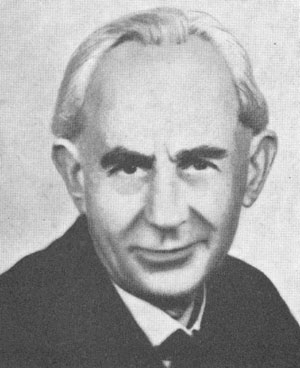[p. V] Helmer Smith
 HELMER SMITH; 26th April 1882 — 9th January, 1956
HELMER SMITH; 26th April 1882 — 9th January, 1956
At the death of Helmer Smith the Critical Pāli Dictionary has lost one of its prime movers and the study of Indian philology a characteristic figure, a scholar of exceptional learning and penetration.
Helmer Smith was born in Stockholm in 1882.* Having taken the degree of M. A. (fil. lic.) at the University of Uppsala in 1908, he became Reader (docent) in Indian Philology at the University of Lund in 1921 and in 1936 was appointed Professor of Comparative Philology and Sanskrit at the University of Uppsala.
Helmer Smith received the honorary doctorate from the University of Lund in 1925. He became an honorary member of the Société asiatique of Paris in the same year, a foreign member of the Royal Danish Academy of Sciences and Letters in 1927, and an honorary member of the Royal Asiatic Society of Ceylon in 1949. This last honour which he received in his old age gave him special satisfaction.
When Dines Andersen and Helmer Smith in 1924 began the edition of the Critical Pāli Dictionary, they had both been active as editors of Pāli texts, and to some extent they looked upon this work as preparatory to their lexicographical project. They had jointly edited the Sutta-nipāta in 1913 (new and revised edition succeeding the editio princeps by Fausbøll) and the two small grammatical texts, Dhātupāṭha and Dhātumañjūsā in 1921. Dines Andersen had published the Pāli Reader, containing some hitherto unedited texts, and Helmer Smith the Paramatthajotikā in four volumes in 1915 to 1918. In 1925 he was called upon by the Pali Text Society to edit the commentary [p. VI] on the Yamakavagga of Dhammapada, that part of Norman's work being out of print. And in 1928 followed the first volume of his monumental edition of the grammatical work Saddanīti, of which five volumes have appeared, the sixth and last volume (ɔ: 5,2 — word-index continued) being in preparation by Dr. Nils Simonsson in Uppsala. The text itself is voluminous, taking up three volumes, in all 928 pages. To this Helmer Smith added in the following volumes very important aids: concordances to Aggavaṁsa's Saddanīti and the works of other Pāli grammarians, indexes of words and quotations, and a chapter called Conspectus terminorum, but being in reality a detailed systematic account of the doctrines of the Pāli grammarians. The character of this chapter, remarkable for its penetration and precision, will easily escape notice, since the author with characteristic modesty has camouflaged it so well, but as a matter of fact it ought to be considered an indispensable introduction by anybody studying the Indian grammarians.
His whole intellectual disposition qualified Helmer Smith for philological studies. His keen intelligence and quick comprehension permitted him to master languages and to surmount interpretative difficulties with exceptional ease. In Sanskrit, Pāli and Prākrit his reading was extensive; he studied a number of modern Indian languages and literatures, especially Sinhalese, Hindi, Tamil, Burmese; and besides he was an excellent classical scholar and possessed a very good knowledge of Old Norse language and literature.
Helmer Smith's editions bear the same stamp of mastery as do V. Trenckner's Pāli publications. They are based on a broad examination not only of manuscripts, but also of parallel texts and commentaries in Pāli, Sinhalese, and Burmese. Besides, metrical studies are included as further correctives in establishing the text.
The Critical Pāli Dictionary benefited by Helmer Smith's ability as a textual critic. Besides drafting articles, making excerpts from unexamined texts and adducing Sinhalese and Burmese commentary passages he saw it as one of his obligations in his dictionary work to give a critical examination of the quotations. He badly felt the deficiencies of a number of Pāli editions, and a great many of his articles contain important textual emendations. In this connection may be mentioned the valuable appendix to the first volume of the dictionary, the Epilegomena, which is his work and which contains a lot of bibliographical information not easily obtained elsewhere.
Helmer Smith spent several years in Paris, where he became an intimate friend of J. Bloch and other French linguists and philologists. In 1926—27 he gave at the request of the French Minister of Education a series of lectures on "Le bouddhisme de langue palie" at the Sorbonne. Otherwise a great deal of his time in Paris was devoted to linguistic studies. He was strongly influenced by the thoughts of French linguists at the time who did not study a language as an isolated unit, but saw it in its relation to other cognate and geographically adjoining idioms as a product of the interplay of foreign and native forces. In connection with his Pāli readings he began at an early date to study Sinhalese, and in 1930 he read a paper in the Société de linguistique of Paris, giving the solution of a much discussed problem of Sinhalese sound history [p. VII] (see his article "W. Geiger et le vocabulaire du singalais classique", Journal asiatique 1950 p. 190). It is characteristic that it was certain features of Swedish which led him to his theory. W. Geiger in the preface to his Grammar of the Sinhalese Language 1938 has acknowledged it in the following words: "By his ingenious observation of the influence exerted on the phonology by heavy or light syllables Professor Helmer Smith has considerably enhanced our knowledge of Sinhalese vocalism". With this one should compare Smith's own statement loc. cit. "Gette observation qui ne pouvait ne pas s'imposer à un autodidacte en singalais littéraire qui savait tant soit peu de vieux suédois", and it will probably be agreed that one could hardly imagine modesty carried farther. It is typical that only in 1950 did Helmer Smith publish his views on Sinhalese in the above-mentioned article, but then the result was a fundamental contribution containing a wealth of observations and dealing with most aspects of the language; its affinity with other Indo-Aryan languages, its vocabulary (discussing influences from Pāli, Tamil, Sanskrit), phonology and morphology. It will remain an important source of information in all future research on Sinhalese. Another weighty linguistic contribution is "Le futur moyen indien et ses rythmes" (J. as. 1952) where a new interesting explanation of certain Middle Indo-Aryan future-forms has been given. In a number of articles in the two journals of the Société de linguistique from 1932 to 1935 Helmer Smith has treated other problems from Middle and New Indo-Aryan languages. The series of three articles called "En marge du vocabulaire Sanskrit des bouddhistes" contains observations on text-criticism, vocabulary, and stylistics of texts in Buddhist Sanskrit.
Through his editorial work Helmer Smith saw the importance of metrical studies for the establishment of the texts, and after 1950 he published several articles on the subject.
Helmer Smith's publications are not easily read. One has a feeling as if they were written at a breath, the style is elegant, but condensed to the extreme, almost hurried. His way of writing reflects his lively, enthusiastic, but also nervous and restless mind. He could be rather sarcastic in his judgment of others. But everyone who has had the benefit of learning to know this exceptionally gifted and witty man, remembers his lovableness and his unselfishness. If a certain shyness would often prevent him from publishing his ideas, he generously communicated them to colleagues orally and in letters, and many scholars have had occasion to thank him for suggestions, to mention a few, J. Bloch in Vindo-aryen, W. Geiger in his Grammar of the Sinhalese Language, and the present writer in the Syntax of the Infinite Verb-forms of Pāli. He was a prodigious letter-writer. This was his natural medium, here he felt altogether free and easy, and he would subject his friends to veritable bombardments with letters, small wonders of wit and learning, teeming with acute ideas and flashes of humour. Dines Andersen collected the letters he received from him and they are now incorporated in the library of the Critical Pāli Dictionary.
Even if Helmer Smith's publications, discounting the text editions, were not extensive, he has nevertheless exercised considerable influence through the [p. VIII] originality of his works and through the many suggestions he made to others. His greatest achievements were no doubt his Sinhalese contributions and his edition of and commentary to the Saddanīti. By them as well as by his work at the Critical Pāli Dictionary his name will be remembered for a long time to come.
Hans Hendriksen
HELMER SMITH'S PUBLICATIONS
by Mrs. Ellen Smith
- The Sutta-Nipāta. New edition. London 1913. Together with D. Andersen. (Pali Text Society.)
- The Khuddaka-Pāṭha, together with its commentary Paramatthajotikā 1, edited from a collation by Mabel Hunt. London 1915. (Pali Text Society.)
- Sutta-Nipāta commentary, being Paramatthajotikā 2, edited. 1—3. London 1916—1918. (Pali Text Society.)
- The Pāli Dhātupāṭha and the Dhātumañjūsā, edited with indexes. Tog. with D. Andersen. Kbhvn. 1921. (Det Kgl. Danske Videnskabernes Selskab, Hist.-filol. meddel., 4:6.)
- A Critical Pāli Dictionary, begun by V. Trenckner, revised, continued, and edited. Vol. I (with Epilegomena). Tog. with D. Andersen. Copenh. 1924—48.
- The Commentary on the Dhammapada. New edition, 1:1. London 1925. (Pali Text Society.)
- Saddanīti, la grammaire palie d'Aggavaṁsa. Texte établi. 1—5,1. Lund 1928—1954. (Skrifter utg. av Kungl. Human. Vetenskapssamfundet i Lund, 12:1—5,1.)
- Désinences verbales de type apabhraṁça en pali. (Bull. de la Soc. de Linguist. de Paris, 33,1932.)
- Descendants de nikaṭa et nikṛṣṭa en néo-indien. (Ib., 34, 1933.)
- Singhalais ruval "la voile". (Ib.)
- Hindi sabh "tous" et les génitifs à désinence multiple. (Ib., 36, 1935.)
- Quatre notes [à propos de l'article Le traitement du groupe Sanskrit sifflante + m et la désinence du locatif en moyen-indien, par J. Bloch]. (Mém. de la Soc. de linguist. de Paris, 23, 1935.)
- Materialien zu den iranischen Pamirsprachen, von H. Sköld. Im Auftrage der Königl. Gesellschaft der Geisteswissenschaften zu Lund aus dem Nachlass herausgegeben. Lund 1936. Tog. with G. Morgenstierne and G. Jarring. (Skrifter utg. av Kungl. Human. Vetenskapssamfundet i Lund, 21.)
- Wörterverzeichnisse. (Ib.)
- Metriska tabeller. Uppsala 1940.
- Några indoeuropeiska kasus. Uppsala Universitets Årsskrift 1945:12. (Språkv. Sällsk.s i Upps. förhandl. 1943—45.)
- Wilhelm Geiger et le vocabulaire du Singalais classique. (Journal asiatique, 1950.)
- Archaic verses in Daśabhūmīśvara. (Journal of the Ceylon branch of the Royal Asiatic Society, N. S., 1, 1950.)
- Les deux prosodies du vers bouddhique. (Human. Vetenskapssamfundets i Lund Årsberättelse, 1949—50.)
- Retractationes rhythmicae. Helsinki 1951. (Studia Orientalia, 16:5.)
- Le futur moyen indien et ses rythmes. (Journal asiatique, 240, 1952.)
- Inventaire rythmique des Pūrva-Mīmāṁsā-Sūtra. Uppsala Universitets Årsskrift 1953:8.
- Analecta Rhythmica. (Studia Orientalia 1954.)
- En marge du vocabulaire Sanskrit des bouddhistes. 1. (Orientalia suecana II 1953.)
- En marge du vocabulaire ... 2. (Orientalia suec. III 1954.)
- En marge du vocabulaire ... 3. (Orientalia suec. IV 1955.)
* My thanks are due to Mrs. Ellen Smith for information received from her.
A Critical Pāli Dictionary Online is maintained by the Data Center for the Humanities at the University of Cologne in cooperation with the Pali Text Society. The project was originally carried out by the Department of Cross-Cultural and Regional Studies (ToRS) at the University of Copenhagen. It has been set up again in 2016 by Marcello Perathoner (Cologne Center for eHumanities) • Contact: cpd-contact@uni-koeln.de • Data Privacy Statement (German)

